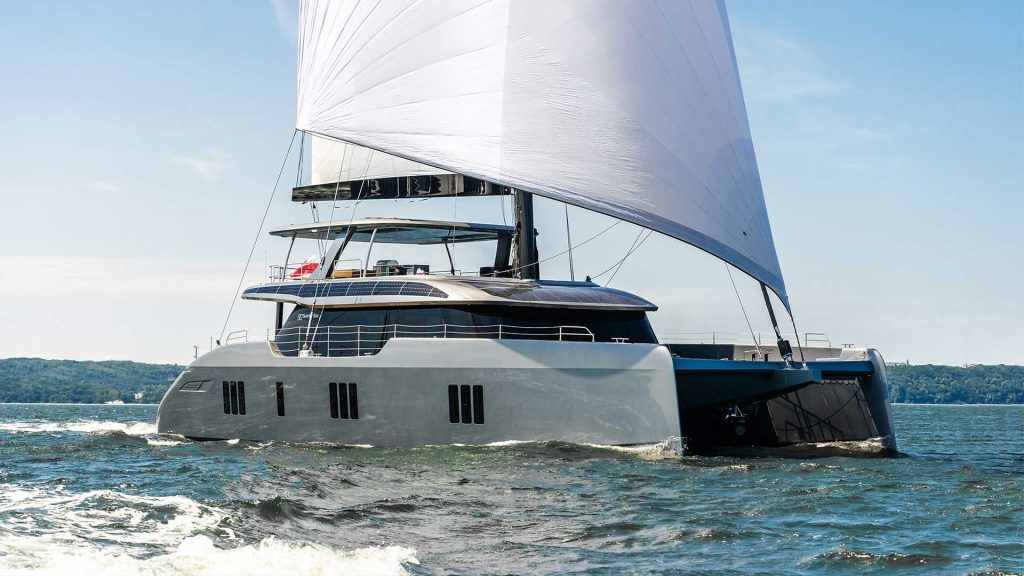Understanding The Basics of a Sailing Yacht

A sailing yacht is the perfect medium for relaxing on the waters on an excursion with friends and family or pursuing an extended transatlantic adventure. It primarily uses wind power to propel the vessel through the water. Today, we talk about the intricacies of a sailing yacht and its many distinct parts.
Parts of a Sailing Yacht
1. The Hulls in Numbers
A hull is a watertight body of the yacht that sits on water. There are different types of hulls, each affecting the stability and speed of a sailing yacht differently hence altering the sailing experience.
Displacement hulls, or round bottom hulls, are designed to push water aside when moving forward with minimum propulsion. Unfortunately, these hulls are often limited to slower speeds. A more preferred option is planing hulls with V-shaped or flat bottoms, designed to glide on top of water when powered sufficiently.
What is more to know is that sailing yachts may differ in terms of hulls also. Monohulls with a single hull typically sport a round bottom. On the other hand, catamarans have two hulls providing increased stability and greater ability of going at higher speeds. A third, lesser popular version is a trimaran with three hulls that cut through the waters without creating too much resistance.
2. Types of Masts
Depending on how large the sailing yacht is, there may be more than one masts onboard. The always present, mainmast is the tallest mast located in the center of the ship – this may or may not be followed by a foremast (in the front of the mainmast, near the bow of the yacht) and a Mizzen mast (immediately in the back of the mainmast).
Sunreef Yachts is known to deploy a carbon fiber mast onboard as it is estimated to retain its strength for twice as long in comparison to an aluminium mast. Additionally, it offers more stability enabling more power on different points of sailing with lesser pitching and rolling as a result of the lesser resistance experienced to move forward.
3. Anatomy of the Sail
The sail is the driving force of the vessel; however, it is inevitable for results to vary based on wind and weather conditions.
The mainsail, also called the principal sail, has its forward edge attached to the mast but is set on the backside of the mainmast, enabling it to act as the primary source of propelling the vessel windward. Its bottoms are also connected to the boom for ease of movement and operations. On the other hand, the jib sits forward of the mast – it is important to note that when the jib overlaps the mast and mainsail because of its huge size, it is then called a genoa. The genoa may partially or completely cover the mainsail to increase the speed of the sailing yacht as desired.
Two lesser-known types of sails are spinnaker and Gennaker. A spinnaker is a large, symmetrical sail that does not cover the mast – while it does reach different points of sail, it is not recommended to use a spinnaker in rough conditions. Alternatively, the Gennaker combines the best of a genoa and spinnaker, allowing to be more versatile.
Here is a more detailed overview of parts of the sail:
Luff is the forward edge of a sail – in case of the mainsail, the luff is usually hoisted up and attached to the mast, whereas the luff of the jib is attached the forestage. Likewise, the leech is the sail’s back edge while the foot is it bottom edge. Supporting the foot is the boom, a pole that significantly improves the shape of the sail and improves the control of the angle by keeping the bottom of the sail flatter.
Between the luff and foot lies the tack, which is attached to either the boat or spar. The triangle forming between the foot and leech is called the clew, while the one at the top, between the leech and luff is called the head. Some sails may also include a batten which is a solid rod or slat used to help maintain the desired airfoil shape.
4. A Brief on Rigging
The arrangement of the mast, sails, and rigging (the system of ropes, cables, and chains) is collectively known as the sailing yacht’s rig which holds the system up. Since the rigging itself has one too many parts (which will require us to call in an engineer), lets just leave it at: the rigging is what supports and controls the mast, sails, and other related parts of a sailing yacht.
Sailing Yachts by Sunreef Yachts
As a multi-award-winning designer and manufacturer of luxury sailing catamarans, Sunreef Yachts has made significant advancements to the usual sailing strategy. Apart from gliding the waters propelled by the natural force of the wind, these sailing yachts are equipped with twin engines for auxiliary power.
The luxury sailing yachts from the shipyard are available in sizes 50, 60, 70, 80, and 100 in classic and eco versions. Recently, the Sunreef 100 Eco has been honoured with the Best Eco Yacht 2024 at the prestigious Best of the Best Awards. In addition, the Sunreef 35M and Sunreef 43M are also sailing superyachts from Sunreef Yachts. These are bespoke luxury catamarans that can be custom made to match the preferred lifestyle of the owner.
Frequently Asked Questions
What is the definition of a sailing yacht?
A sailing yacht is a leisure vessel that uses the attached sails as its primary means of propulsion. While sailing yachts may vary in size and complexity, the basic components remain similar – for starters, each sailing yacht has a hull or more to carry the passengers and support the rigging (which consists of the mast, sail, and halyards/chains).
How much do sailing yachts cost?
The multi-award-winning sailing yachts from Sunreef Yachts are available in sizes 50, 60, 70, 80, and 100; to know more about the prices of each of these models reach out to our representatives. Over the years, luxury sailing yachts have offered lucrative returns on investment when maintained well overtime.
Do sailing yachts have engines?
Sunreef Yachts combines motors with sails to offer more functionality onboard. This makes the sailing concept more practical when dealing with sailing gear related issues, little to no winds, and when manoeuvring tighter spaces.



